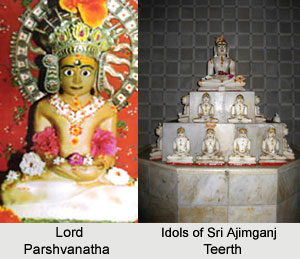 Shri Ajimganj Teerth located in West Bengal is a Jain pilgrimage centre. The teerth kshetra is situated on one side of the Bhagirathi River. On the other side Jiyagangh teerth is located. The temple is dedicated to Lord Parshvanatha, the twenty-third Jain Tirthankara
Shri Ajimganj Teerth located in West Bengal is a Jain pilgrimage centre. The teerth kshetra is situated on one side of the Bhagirathi River. On the other side Jiyagangh teerth is located. The temple is dedicated to Lord Parshvanatha, the twenty-third Jain Tirthankara
Temple of Shri Ajimganj Teerth
As per the history of Shri Ajimganj Teerth it is a very ancient teerth. The swetambara temple houses the idol of Shri Chintamani Parshvanatha Bhagwan. The temple has been beautifully decorated with intricate designs. These stand as unique example of ancient art and boast about the skills of the craftsmen. The walls and pillars of the temple are adorned with specimens of ancient art and paintings. The idol of the Lord is 39 cm in height and is copper coloured. It is seated in a padmasana posture. The idol has been beautifully carved from a single stone and looks very appealing. The smiling face of the Lord looks very calm and serene.
The Temple of Sri Ajimganj Teerth organizes many annual gatherings and functions that are celebrated with much enthusiasm. There are provisions for dharamshalas or rest houses for the pilgrims that are well equipped with all modern facilities. There are also facilities for Upashrays, Ayambilshala and Jnanabhandar. The teerth being situated amidst beautiful natural surroundings attracts many pilgrims. The surrounding greenery and the beauty of the teerth mesmerize and fascinate the pilgrims. The calm and tranquil village environment makes it a perfect place for religious activities. The kshetra is well connected to road, rail and air. Taxi services and bus services are easily available here. The nearest bus stand and railway station is located in Jiaganj. The closest airport id located at Kolkata.




















